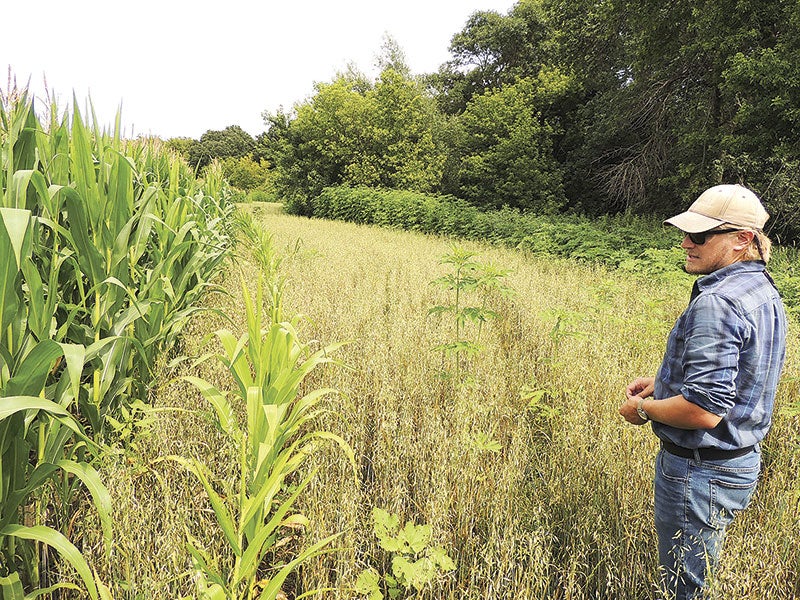State offers new options for buffer compliance; Mower SWCD received $60K to aid landowners
Published 6:00 am Thursday, August 31, 2017

- Aaron Gamm, a Mower County Soil and Water Conservation District technician and the local buffer coordinator, checks a newly established vegetative buffer next to a corn field in July along Roberts Creek in northern Mower County. Photo provided by SWCD
By Tim Ruzek
tim.ruzek@mowerswcd.org
Mower County’s agricultural landowners now have an additional cost-assistance option to help bring fields into compliance with the state buffer law.
The Legislature allocated the Soil and Water Conservation District offices
$5 million to use as cost-share assistance when working with ag landowners to comply with the state buffer law. It is from the state’s Clean Water Fund.
Mower SWCD will get $60,000 to offer cost-assistance contracts with landowners to implement buffers or alternative practices along public waters and public ditches.
Buffer legislation this year also allows for an eight-month extension for landowners to implement buffers along public waterways, extending the Nov. 1, 2017, deadline to July 1, 2018. Legislators passed the extension in recognition of some landowners possibly having hardships, such as weather, in meeting the deadline.
Getting an extension, however, will require landowners or authorized agents to file a riparian protection compliance plan by Nov. 1, 2017, with their local SWCD office.
Buffers on public drainage ditches must be implemented by Nov. 1, 2018.
Buffers are areas or strips of land kept in permanent vegetation – not farmed – to slow water runoff and help filter out pollutants, such as phosphorus and nitrogen, as well as sediment. They also provide wildlife habitat and stabilize land along water.
Under the 2015 law, landowners need to establish on public waterways a buffer averaging 50 feet wide with no less than 30 feet in any spot, unless approved for alternative practices. Public ditches must have at least 16.5 feet of buffer on each side.
Prior to the law, Mower County had 95 percent compliance for acreage along public waterways.
In January 2017, Aaron Gamm, Mower SWCD’s buffer coordinator, sent more than 300 letters to Mower County ag landowners who appeared to have land without adequate buffer. Addressing needs on about 400 parcels, the letters included maps and an overview of the buffer law.
About 50 percent of those tagged parcels, however, involve landowners who have yet to communicate with Mower SWCD about their buffer needs, Gamm said. He planned to send additional letters in August to all landowners who still need to add buffers, including those who have spoken with him about their plans but won’t plant seeds until after harvest.
“We need to hear from all landowners contacted by our office to ensure they’re complying with the state law and that any inaction won’t affect their eligibility for future conservation and federal farm programs,” Gamm said.
Mower County staff is considering how to enforce the state buffer law locally.
This year, Mower SWCD adjusted its programs to make staff more available to assist with buffer compliance. Mower County also committed resources in 2017 to Mower SWCD to ensure landowners can get buffer assistance before the Nov. 1 deadline.
Staff at Mower SWCD have been providing technical assistance to landowners for measuring, staking, seeding and layout designing for buffers as well as offering programs that help landowners offset the loss of productive cropland.
One of those options came out in May with the new round of the Conservation Reserve Enhancement Program (CREP) in Minnesota –a voluntary program offering landowners higher payments to permanently protect cropland from being farmed again.
Since the buffer issue emerged, Mower County landowners also have enrolled more than 4,000 acres into the federal Conservation Reserve Program (CRP) that typically involves conservation easements of 10 to 15 years.
For more information contact Aaron Gamm at Mower SWCD at 507-434-2603 or by email at aaron.gamm@mowerswcd.org.
New state buffer cost assistance
Who: Mower County ag landowners needing buffer.
What: An additional state cost-assistance option to help them comply with the state buffer law.
Where: Mower County and the rest of Minnesota.
When: Landowners need to comply by Nov. 1, 2017, for public waterway buffers or apply for 8-month extension.
Online:
bwsr.state.mn.us/buffers
dnr.state.mn.us/buffers
mowerswcd.org



